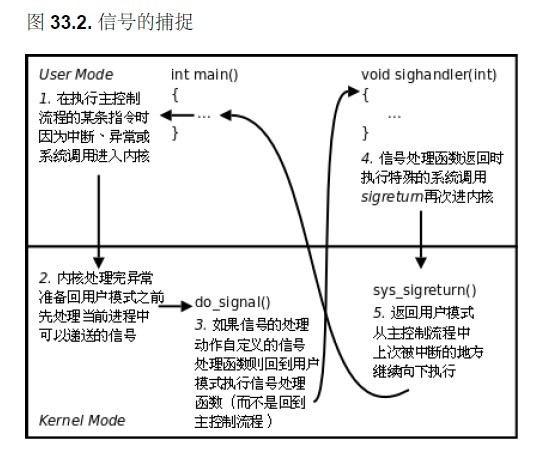A Demo of Posix Signal
数据结构和 API 介绍
// 信号配置中最关键的数据结构
struct sigaction {
void (*sa_handler)(int); // 信号触发钩子函数(简单版)
void (*sa_sigaction)(int, siginfo_t *, void *); // 信号触发钩子函数(复杂版)
sigset_t sa_mask;
int sa_flags; // 一些标识位,下面会介绍
void (*sa_restorer)(void);
};
// 几种常用的sa_flags:
// SA_SIGINFO ==> 触发信号后会调用更强大的 sa_sigaction()
// SA_ONSTACK ==> 使用单独的栈运行handler,避免函数太大撑爆原来程序栈
// SA_RESTART ==> 使信号触发可以打断阻塞状态(如read()等待),
// 此时errno将被置为 EINTR
// 为某个信号自定义触发handler,以及某些配置项
int sigaction(int signum, const struct sigaction *act,
struct sigaction *oldact);
// 在当前进程中触发一个信号
int raise(int sig);
// 向pid进程发送一个信号(本案例中用不到)
int kill(pid_t pid, int sig);
信号从触发到被捕获的过程

简单版 Demo
只有一个进程
- 为
SIGUSR1设置 handler - while(1)循环接受用户输入字符
- 当输入 q 时为当前进程触发信号
- 进入设定的信号 handler,设置进程退出标志
- 进程退出,终止
#include <stdio.h>
#include <string.h>
#include <signal.h>
#include <assert.h>
static int need_exit;
static void
sig_handler(int sig)
{
assert (sig == SIGUSR1);
printf("SIGUSR1 triggered! Set need_exit, program will exit\n");
need_exit = 1;
}
static void
install_signal_handler()
{
struct sigaction s;
int ret;
memset(&s, 0, sizeof(s));
s.sa_handler = sig_handler; // 重设信号的处理函数
// struct sigaction 的其他参数暂不关心
ret = sigaction(SIGUSR1, &s, NULL);
assert(ret == 0);
}
int
main(void)
{
char c;
pid_t pid;
install_signal_handler();
while ((c = getchar())) {
// printf("char: %c:\n", c);
if (c == 'q') {
raise(SIGUSR1);
}
if (need_exit)
break;
}
return 0;
}
高级版 Demo
- 设置 SA_SIGINFO 标志,即启用参数更多的 handler
- 实现简易的批处理系统?
- info.si_addr 来判断发生的地址,
重新注册了三个信号的 handler,分别有不同的作用
- SIGUSR1 模拟用户态程序发送 IO 请求
- SIGUSR2 模拟用户态程序调用 yield()主动让出 CPU
- SIGVTALRM 模拟 timer 中断
- SIGSEGV 不是显式触发,程序执行出错自动触发被捕捉。
- 出错可能有多种原因,利用 hangler 中的
siginfo_t参数区分不同情况 siginfo_t的结构和成员说明在下方- 主要用到 si_addr, si_code 来区分 syscall、iret、page_fault 行为
- 出错可能有多种原因,利用 hangler 中的
static void
sig_handler(int sig, siginfo_t *info, void *ucontext) {
thiscpu->ev = (Event) {0};
thiscpu->ev.event = EVENT_ERROR;
switch (sig) {
case SIGUSR1: thiscpu->ev.event = EVENT_IRQ_IODEV; break;
case SIGUSR2: thiscpu->ev.event = EVENT_YIELD; break;
case SIGVTALRM: thiscpu->ev.event = EVENT_IRQ_TIMER; break;
case SIGSEGV:
if (info->si_code == SEGV_ACCERR) {
switch ((uintptr_t)info->si_addr) {
case 0x100000: thiscpu->ev.event = EVENT_SYSCALL; break;
case 0x100008: iret(ucontext); return;
}
}
if (__am_in_userspace(info->si_addr)) {
assert(thiscpu->ev.event == EVENT_ERROR);
thiscpu->ev.event = EVENT_PAGEFAULT;
switch (info->si_code) {
case SEGV_MAPERR: thiscpu->ev.cause = MMAP_READ; break;
// we do not support mapped user pages with MMAP_NONE
case SEGV_ACCERR: thiscpu->ev.cause = MMAP_WRITE; break;
default: assert(0);
}
thiscpu->ev.ref = (uintptr_t)info->si_addr;
}
break;
}
if (thiscpu->ev.event == EVENT_ERROR) {
thiscpu->ev.ref = (uintptr_t)info->si_addr;
thiscpu->ev.cause = (uintptr_t)info->si_code;
thiscpu->ev.msg = strsignal(sig);
}
setup_stack(thiscpu->ev.event, ucontext);
}
// signal handlers are inherited across fork()
static void
install_signal_handler() {
struct sigaction s;
memset(&s, 0, sizeof(s));
s.sa_sigaction = sig_handler;
s.sa_flags = SA_SIGINFO | SA_RESTART | SA_ONSTACK;
__am_get_intr_sigmask(&s.sa_mask);
int ret = sigaction(SIGVTALRM, &s, NULL);
assert(ret == 0);
ret = sigaction(SIGUSR1, &s, NULL);
assert(ret == 0);
ret = sigaction(SIGUSR2, &s, NULL);
assert(ret == 0);
ret = sigaction(SIGSEGV, &s, NULL);
assert(ret == 0);
}
siginfo_t
从 siginfo_t 中截取了某些关键成员,对他们的含义进行说明:
// [si_code] indicating why this signal was sent.
// 需要 man sigaction 才能找到对应与某个信号的所有si_code。
// [si_addr] the address of the fault.
siginfo_t {
int si_signo; /* Signal number */
int si_errno; /* An errno value */
int si_code; /* Signal code */
int si_trapno; /* Trap number that caused
hardware-generated signal
(unused on most architectures) */
pid_t si_pid; /* Sending process ID */
uid_t si_uid; /* Real user ID of sending process */
int si_status; /* Exit value or signal */
union sigval si_value; /* Signal value */
void *si_addr; /* Memory location which caused fault */
int si_fd; /* File descriptor */
}
参考
- 南京大学 AM 中 native 实现 CTE 的方案